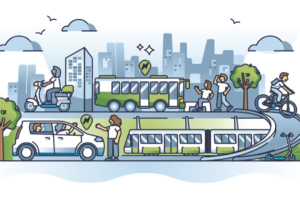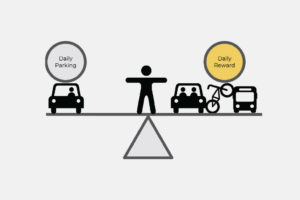By Adamo Donatucci
In the parking and mobility industry, technology is pivotal in shaping its future. Across the globe, certain nations are at the forefront, strategically embracing advancements such as autonomous vehicles, micromobility solutions, intermodal applications, and shared zero-emission initiatives.
Below is a comprehensive exploration of various country policies, exploring the complex process of technological adaptation and their concerted efforts toward achieving ambitious zero-emission goals.
1. Autonomous Vehicles — A prominent force at the forefront of the automotive industry.
Undoubtedly, autonomous vehicles (AVs) have become a focal point in the mobility industry in recent years. According to a recent study by the global management consulting firm McKinsey & Company, passenger car advanced driver-assistance systems and autonomous-driving (AD) systems could generate $300 to $400 billion in revenue by 2035. Level 4 high-driving automation is anticipated to contribute $170 to $230 billion, accounting for approximately 57% of the dominant vehicle type in sales. Overall, the expectation is that 12% of new passenger cars sold by 2035 will incorporate Level 3 and 4 autonomous technologies, with 37% featuring advanced AD technologies.
For years, global car manufacturers, particularly in the United States and Europe, have promised a future of self-driving vehicles. However, recent trends suggest China is poised to lead the global shared AVs market. Research indicates that the top 5 regions in China collectively command 51.3% of the total autonomous mobility market. At the same time, the United States holds 47.5%, and Europe (including the United Kingdom, France, Spain, and Germany) accounts for 62.3%.
Government support is a crucial factor in fostering AV adaptation. Since 2020, over $48 billion has been invested in AVs, with the US leading in investments in 2020 ($7.3 billion) and 2021 ($11.3 billion). China surpassed the US by investing $4.7…
From left to right: Hendrik Pot, CFO at WPS, Giovanni Santamaria, Managing Partner at Certina, Erik Stronk, CEO at WPS
WPS Parking Solutions, specialists in innovative cloud-based parking management solutions has been acquired by Munich-based family-run industrial holding company CERTINA GROUP. With over 25 years of experience in building and reshaping companies, CERTINA will further invest in WPS, its solutions, customers and employees to drive innovation and growth within the parking industry.
The sale of WPS Parking Solutions to CERTINA will result in the separation of the current WPS organization. WPS North, including WPS Belgium, WPS Parking Systems (NL), WPS Canada, WPS UK, WPS US, and WPS Holding, will now be part of CERTINA’s portfolio of companies. WPS North will continue to operate as an individual company under CERTINA.
WPS Brazil, as an independent company within the WPS family, will not be sold. The current shareholders, local management and Egeria, will continue WPS operations in Brazil and South America in its current form.
WPS and CERTINA are committed to ensuring continuity and growth in the parking management solutions industry. The acquisition is an exciting opportunity for WPS to enter the next phase of its development with a new owner who has extensive experience in building and reshaping companies.
Erik Stronk, CEO at WPS Parking Solutions: ‘’We look forward to a bright future that we will realize together with CERTINA. With their investments made according to the principles of sustainability, continuity and corporate responsibility, we find the ideal partner in CERTINA to help us navigate changing market conditions and further invest in our products, employees, and growth. I am confident that this acquisition will accelerate innovation and success for our business and customers.”
Giovanni Santamaria, Managing Partner at CERTINA: “We are excited to welcome WPS Parking Solutions to the CERTINA family of companies. With our extensive…
Collaborative solution improves commuting, parking experiences
MONTRÉAL, August 3, 2022— Genetec Inc. (“Genetec”), a leading technology provider of unified security, public safety, operations, and business intelligence solutions, has teamed with commute management solutions provider RideAmigos to help organizations deliver a simplified and enhanced experience to commuters returning to offices post pandemic. The solution pairs RideAmigos Commute Hub with Genetec AutoVuTM Free-Flow and Genetec Curb SenseTM .
RideAmigos Commute Hub helps employers deliver a seamless experience no matter how their employees choose to get to the office. It enables commuters to identify their best transportation options and reserve a guaranteed parking space based on their needs, such as accessible parking, eliminating the need to circle lots in search of a space, and alleviating some of the stress of getting to work.
Space availability is guaranteed via automatic license plate recognition (ALPR) cameras. The pairing of RideAmigos’ Commute Hub with Genetec AutoVu Free-Flow and Genetec Curb Sense gives parking officials full insight into parking demand and facility status, so they can ensure parking conditions are optimal. The solution also enables employees to choose from many transportation options such as mass transit, shuttles, carpooling, and active choices like biking to work, so they select the commute that is the most beneficial and enjoyable on any given day.
“Leaders at large organizations realize that commuting options are a critical part of the overall employee experience, particularly as people transition back to offices after being fully remote,” said Genetec Product Line Manager, AutoVu, Michael Bradner. “Streamlining the commuter experience can help boost employee satisfaction and productivity. Our goal with this joint solution is to help organizations optimize accessibility and use of parking spaces and provide or subsidize alternative transportation services to reduce the burden on employees.”
“Employers are more conscious than ever…
By Adamo Donatucci
The last mile of any journey is often the most fraught.
This phenomenon was first conceptualized by utilities and communications providers that were able to, for example, deliver their products to a neighbourhood easily but then experienced challenges connecting individual homes.
Likewise, logistics companies can easily coordinate delivering many goods to a central depot, but often experience difficulty finalizing the delivery to individual homes because a signature is required but the homeowner isn’t available. It’s also the most expensive and time-consuming part of the logistics lifecycle, so there’s a great deal of interest in finding more efficient solutions.
Similar matters occur in the realm of parking: getting to a concert venue downtown is easy enough but finding an affordable parking space nearby can be consuming.
As an increasing proportion of the world’s population lives in urban centres and those centres become increasingly dense, we can expect these dilemmas to worsen over time. To address these matters as they arise, companies are leveraging people’s interconnectedness with technology to develop solutions that are flexible and sustainable.
Last-Mile Parking Technology
Ninety-eight percent of parking transactions today leverage technology at some point in the transaction process. This includes anything from a driver visiting a pay-on-foot kiosk on their way back to their vehicle before leaving a parking garage, looking online to compare rates near their intended destination, to scanning a QR code posted near a parking meter to pay for a session without touching a machine.
In the context of the parking industry, last-mile technology includes everything that makes the driver’s life simpler and more convenient and lets them get to their destination more quickly and efficiently. In practical terms, this means reserved parking with ancillary services like electric vehicle (EV) charging and detailing, or apps that locate…
Brendan McEwen – Director, Electric Mobility & Low Carbon Strategies, AES Engineering Ltd.
Over the next two decades, Canadian cities will experience a profound transition from transportation systems dominated by personal vehicles with combustion engines to electric mobility systems. “Electric mobility” encompasses personal electric vehicles (EVs), electric transit, e-bikes, car-sharing, ride-hailing, ride-sharing, and perhaps one day, autonomous robo-taxis. Parking professionals have a crucial role to play in speeding the transition to electric mobility, realizing the benefits that it can provide to their communities and to parking authorities’ bottom line.
The transition to electric mobility will provide financial, safety and quality of life benefits for all members of our community. Depending on where you are in Canada, EVs typically cost 65% to 80% less to fuel than comparable internal combustion vehicles. Likewise, Consumer Reports recently published data confirming that EVs have half the maintenance cost of conventional vehicles. All told, Canada’s 2 Degrees Institute estimates that the average Canadian EV driver will save $27,000 in fuel and maintenance costs over a 10-year operating life.
EVs still currently have higher initial costs than conventional vehicles, due to the cost of batteries. However, battery costs are declining rapidly – industry average lithium-ion battery costs have reduced from approximately $1200/kWh of battery capacity in 2010, to $156/kWh in 2019. Average battery costs are projected to decline to $100/kWh by about 2024, at which point there will be no price premium for EVs. Indeed, Elon Musk recently described how Tesla can achieve costs of approximately $65/kWh in the next three years. Given the improvements in battery technology and manufacturing, sources as diverse as the Canadian Vehicle Manufacturers Association, International Council on Clean Transportation, and Bloomberg New Energy Finance agree that battery cost reductions…
By Brett Bain
Historically, things in airports around parking and transportation have until the last few years, been static. Customers generally followed three standard options for getting to the airport. They drove themselves and parked their vehicle at the airport, they took a taxi or limousine, or they were dropped off by a friend or family member.
Airports in Canada – in most cases – are non-profit organizations that operate under a lease arrangement with the federal government. They do not receive any funding from the government to operate and in fact, pay a minimum of 10% of gross revenues in tax back to the federal government. In addition, they are also required to pay property tax to the jurisdiction in which they reside. As a result, Canadian airports are very reliant on the revenue generated from non-aviation sources which consists primarily of parking, concessions within the airport and real estate revenues. These revenues are reinvested back into the airport for operational expenses and for airport infrastructure and flight development.
Like many businesses, airports have been in transition over the last few years. If we think back a bit, we can all remember that at one time telephone, internet and cable companies were all separate entities which provided a product or service to their customers. These businesses have all blended together into single entities over the last few years as technology has created opportunities for companies to enter into new markets. Parking and transportation at airports are now in the early stages of a similar transformation as transit and/or rail services begin to appear in the airport offerings. Airports are both an economic driver for their region and a reflection of the community which they serve. As cities develop new and expanded forms of transportation to serve their citizens, these are also…
By Roamy Valera
The hottest buzz word among parking leaders right now is mobility. In fact, within and outside the industry, mobility is a primary concern for those who are tasked with shaping our communities. Accountability is being placed on those who impact our ability to move about freely, easily and safely in our urban environment. How we move however, is determined by urban planning for the future. And today, as we are on the cusp of the age of the smart city and self-driving vehicles, the future of mobility is taking shape.
Mobility is about providing efficient access to essential services, employment opportunities, and entertainment and recreational opportunities. For some, that means facilitating car travel; for some it means providing transit resources, as well as first and last mile service for transit users; and for some it means providing safe and convenient pedestrian access. The benefits of providing seamless mobility are enormous: more vibrant economic development, more sustainable communities, and a better quality of life for residents and visitors.
Parking is a critical element in the mobility piece and can make or break our ability to move around our environment efficiently. An estimated 30 percent of traffic in urban areas is caused by drivers looking for parking. How we leverage innovative technology to reduce this friction is key to solving this element and will allow those accountable to our journey to better manage the curb.
Curb Management is the Key
How we manage the curb matters. When vehicles are constantly circling blocks looking for parking, they cause congestion on roadways and pose a hazardous situation for fellow drivers and pedestrians alike. Likewise, when drivers double park, they create similar hazards. So, where do we start?
Curb management begins with Transportation Demand Management (TDM). TDM is a general term describing strategies designed to increase overall…
BY PAULO NUNES-UENO
Parking is out. Mobility is in.
Strolling the vendor booths at the Canadian Parking Association conference in Toronto this year makes that clear. We are all rebranding, it seems. Including me. The group I started at Seattle’s DOT, called the Transit and Mobility Division, manages transit, bikeshare, carshare, and of course, parking. Now as a consultant, I help clients retool their campus and city parking into ‘mobility’ services.
Mobility. Such a sweet word. If you close your eyes, you can almost hear…the future! Unfortunately, the transportation and ecological challenges we face won’t be solved through slogans. And the stakes couldn’t be higher. Get ‘mobility’ right and we stand a chance against climate change. Getting it wrong also spells extinction for those in the parking–I mean mobility–business.
Technology changes and growth make real adaptations all the more urgent. Re-urbanization is transforming cities throughout North America. Companies that a generation ago would have happily sprawled in suburban office parks are packing into downtown skyscrapers. Witness the new Amazon HQs headed to NYC and Washington DC. We can actually see this change happening inside our workplaces. The typical office from the early 2000’s housed 3 or 4 people per 1000 square feet. Today interior designers and architects with open offices and shared workstation have managed to more than double that.
Too bad transportation can’t claim anything close. None of the innovations to date increase the capacity of roadways or parking lots very much.
Driverless cars, the next big ‘innovation’ afoot, will actually make matters worse. Though we don’t know when autonomous vehicles are coming exactly, we can be sure they will impact the urban landscape. How? Because we have experience with services that drop people off at their destination and keep going. They’re called taxis….
By Jennifer Mucha
Toronto Pearson is Canada’s largest airport, and the ninth-busiest airport in North America, moving nearly 50 million annual passengers from security checkpoint to gate to more than 170 destinations around the world. The airport has a mandate to put passengers at the heart of every decision, and as a result was recently recognized by the Airports Council International as the Airport Service Quality best large airport in North America. Believing that the passenger experience starts long before take-off, Toronto Pearson is using technology and analytics to build a diverse and creative transportation offering that ensures travellers have an end-to-end experience tailored to their individual needs, while keeping future aviation demand in its sights.
Toronto Pearson has come a long way from its origins in a farmer’s field in the village of Malton in 1939. The airport grounds now stretch from Mississauga in the west to the city of Toronto in the east and south, and to Brampton in the north. At the heart of three municipalities and close to the 400-series highways, it goes without saying that Toronto Pearson sees high vehicle traffic from passengers, meeters, greeters and employees.
Integrating Parking and Transportation
With nearly 50 million annual passengers, as well as an airport employee community of almost 50,000 workers, efficient transportation into and out of the airport is critical to the success of the operation. An intricate network of municipal transit providers, ground transportation operators and the airport’s own Parking and Ground Transportation business unit work together with a common goal: to ensure that transportation at the airport is integrated, provides a diverse and appropriate range of services and contributes to the airport’s passengers-first mandate.
Achieving that goal is no small feat. Toronto Pearson’s three covered garages and two outdoor lots represent Canada’s…
By Daniele Desjardins
In conjunction with the Canadian Parking Association’s Annual Conference and Trade Show, Parking, the Urban Mobility Perspective, Canada’s 1st Unified Mobility Leadership Summit will be held in Toronto from September 16 to 19, 2018.
The event comes as a result of the long-standing relationship between the Canadian Parking Association (CPA) and the Association for Commuter Transportation of Canada (ACT Canada), the only organization dedicated to sustainable mobility in Canada.
Moreover, the event epitomises the new mission statement adopted unanimously by the CPA Board of Directors at its strategy session held at the start of 2018: Connecting Parking and Mobility Professionals in Canada.
Both organizations’ annual meetings will be held simultaneously under one roof, where delegates are encouraged to take in the shared programming, to underscore the intertwined futures of parking and mobility, and help amplify the CPA’s conference theme.
In 2016, CPA and ACT Canada held concurrent events in Ottawa and shared some sessions and events that were of mutual interest. This year, the partnership between the two organizations has been purposefully strengthened and aligned so that programing is accessible to all delegates. The intent is to position parking as a key component of an overall unified mobility strategy and focus.
The CPA and ACT Canada relationship dates back to 2005, with CPA’s participation on ACT Canada’s National Advisory Team to help identify cross-sector issues that impacted integrated mobility across the country. Back then, a reciprocal agreement was established to formalize the relationship and set up goals to work together collaboratively and develop meaningful synergies, networks and information sharing.
“Since then, the commonalities between the two organizations have evolved not only inwardly, but as a collective undertaking across all transportation and mobility-related sectors. CPA hopes to lead the association market in adapting to new…












